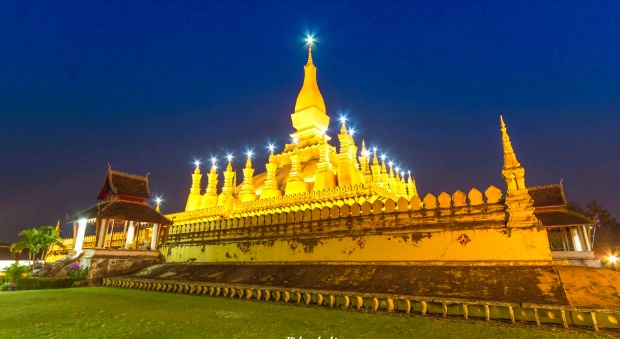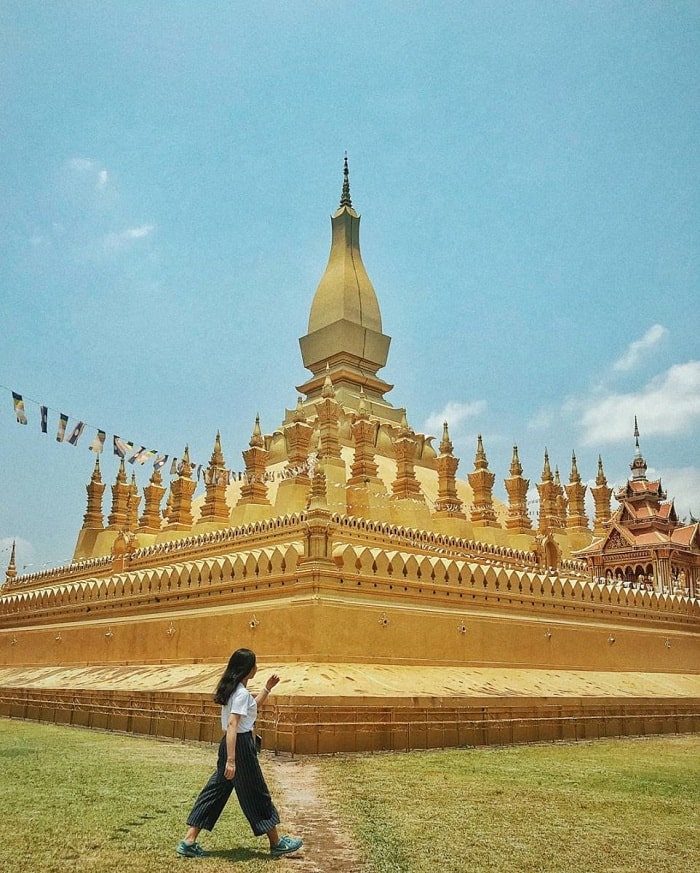Introduction to Pha That Luang Stupa: A Cultural Landmark in Laos
Pha That Luang Stupa is an architectural gem situated in the capital city of Vientiane, Laos. This structure exudes an aura of tranquility, antiquity, and historical significance. Often referred to as the “Golden Temple,” Pha That Luang stands as a paramount national monument, embodying the essence of Laos’ rich cultural and religious heritage.
Architectural Marvel: The construction of Pha That Luang began in 1566 during the reign of King Setthathirath. The stupa’s distinctive design resembles a glistening goblet, enveloped in a layer of shimmering gold. This iconic structure has been honored by featuring on national currency and the emblem of the Lao People’s Democratic Republic.

Historical Legacy: Legend has it that the original Pha That Luang stupa was built as a Hindu temple in the 3rd century. During this time, five Buddhist monks carrying relics, believed to be a piece of Buddha’s breastbone, arrived from the Mauryan Empire under Emperor Ashoka’s guidance. They enshrined the relic within the temple. In the 13th century, the temple was reconstructed in the Khmer architectural style. It eventually fell into disrepair until King Setthathirath transformed the site into a Buddhist stupa during the 16th century.
Restoration and Renovation: In 1828, the stupa suffered extensive damage due to a Thai invasion, resulting in its abandonment for a period. Restoration efforts were initiated in 1990 based on detailed plans from 1867 by French architect and explorer Louis Delaporte. However, these efforts were not fully realized, leading to a subsequent restoration in 1930. After enduring destruction during the Thai-French conflict, Pha That Luang was finally reconstructed after World War II.
Architectural Marvel: Pha That Luang stands as Laos’ foremost architectural marvel. Its vast base spans 90×90 meters, towering to a height of 45 meters. The entire structure is adorned with layers of resplendent gold leaf. The pinnacle of the stupa resembles an ascending giant arrowhead. At its core, there is a square lotus pedestal, symbolizing purity and spiritual enlightenment. This is crowned by an intricate square platform, gradually tapering in size as it ascends to create a stable foundation for the bulbous upper portion.

Symbolic Representation: Pha That Luang’s structure is divided into three tiers, each reflecting a facet of Buddhist doctrine. These tiers are interconnected by a network of 85-meter-long walls, adorned with sculptures that depict the history and teachings of Buddhism. The compound also houses statues of the Buddha, adding to the spiritual atmosphere.
That Luang Festival: One of Laos’ most significant events, the That Luang Festival, takes place annually in December according to the Buddhist calendar. During this celebration, people from all corners of Laos gather in Vientiane to partake in this religious and national occasion. The entire city is adorned with candles, lanterns, and flowers, creating an ethereal ambiance.
Cultural Significance: Pha That Luang is more than just an architectural marvel; it symbolizes the fusion of spirituality, culture, and the creative intellect of the Laotian people. The annual festival adds an extra layer of vibrancy and significance to this iconic monument, making it an essential stop for anyone exploring the cultural treasures of Laos.
In conclusion, Pha That Luang Stupa stands as a testament to Laos’ rich history and spiritual heritage. Its captivating architecture, historical significance, and annual festivities make it a must-visit destination for travelers seeking a deeper understanding of Laos’ cultural tapestry.
> See More


